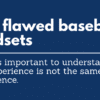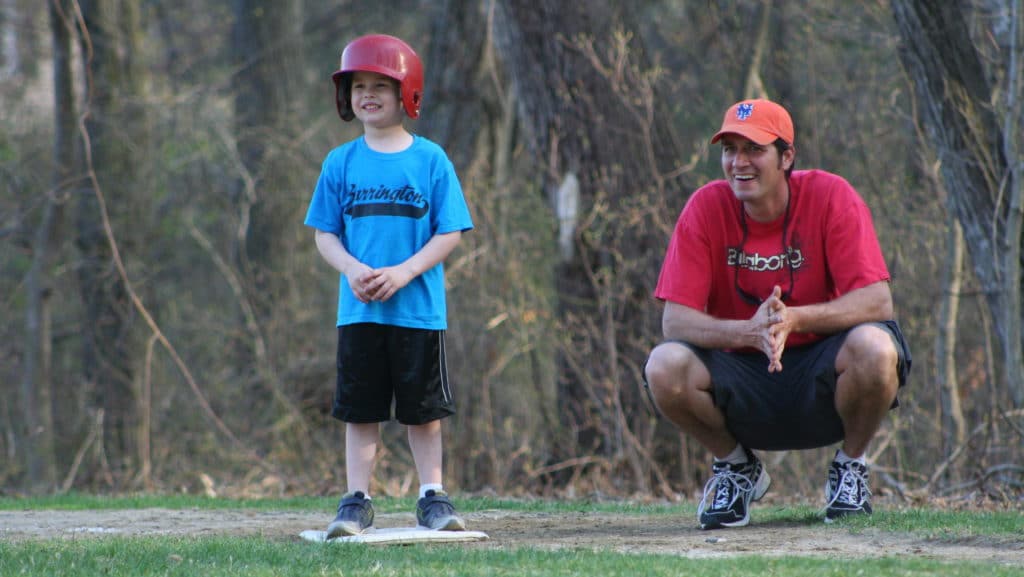Recently, I was browsing a Facebook group for baseball coaches when I found a post that instructed pitchers to run poles after throwing in order to “flush” the buildup of lactic acid from their arm.
For players of a certain age (myself included), that’s a common refrain—running to get rid of lactic acid was something most of us were taught as youth, and we took it as settled fact.
But as noted by The Sporting News in 2016, recent research calls into question both lactic acid’s negative effect on the arm and distance running’s effectiveness in reducing it.
This is important, because aside from it being a poor recovery mode distance running has been flagged as potentially counterproductive for pitchers; it may promote the wrong type of physical development for the movements pitchers execute.
It should go without saying that if having our pitchers run poles after throwing is based on incorrect information, we should end that practice and adopt a program that helps them recover better and develop in a more beneficial way.
So, I posted a comment on that Facebook post asking if the person had any evidence to back up his claim that lactic acid buildup was a problem for pitchers and that running could help solve that problem. I considered this a reasonable question based on a reasonable assumption: As coaches who teach physical training and movements, our opinions should be based on evidence. Predictably—it happens almost every time someone asks for evidence about a claim—the conversation devolved into name calling, credential boasting, and personal attacks.
I can’t tell you how many times I’ve experienced conversations that go like this:
Coach #1: “Pitchers should [insert thing about mechanics here] because it helps them throw the ball faster.”
Coach #2: “Yes, yes, absolutely. That’s what [insert Nolan Ryan, other baseball player] said back in 1975! Just look at this picture!”
Me: “Hey guys, do you have any evidence that proves what you’re saying?”
Coach #1: “Geez, don’t you even understand basic physics! Did you go to school?!”
Coach #2: “Nolan Ryan was one of the greatest pitchers of all time! I think he knows better than you. Also, just look at this picture!”
As a community, we are too stubborn, too invested in our own ideas, and lacking in both intellectual curiosity and rigor. We bristle when asked how we know what we know. We hate being challenged, as if being asked to back up our statements with evidence is a personal attack on our value as coaches. We can’t stand the thought of being wrong—often because our livelihood is tied to our ability to monetize our knowledge—so we’re defensive and combative. All of this harms the game at a systemic level by making it more difficult for us to weed out bad ideas while advancing, refining, and propagating good ideas.
In this post, I want to take a few minutes to talk about process.
Baseball Mechanics: How Do We Know What’s Good or Bad?
Let’s start with a fundamental premise: Knowledge is based on evidence and evidence is observable. This concept is the foundation of physical and social science. Researchers seek to better understand how things work by observing, measuring, and testing objects, forces and effects, and relationships. They run carefully-designed experiments, collect and analyze data, and present their findings in highly-detailed papers. Increasingly, researchers are also expected to make their data publicly available so that other researchers can check for errors.
Those papers undergo a grueling peer review process prior to publication, during which fellow scholars anonymously mark them up, highlighting errors, omissions, flawed logic, or various other problems. This process is arduous and time consuming, and often continues for several rounds. Only when the noted issues have been sufficiently resolved will a paper be published.
Usually, this is what researchers mean when they use the term “science.” While most laypeople, including most baseball coaches, think the term is used to describe concrete physical principles that are taken as fact (such as the basic physics and geometry kids learn in high school), it actually refers to the overall process of collecting, testing, and analyzing data or other evidence in a systematic manner.
Players and Coaches Should Embrace Criticism
Part of that process includes criticism, which scholars recognize as necessary. Every human being brings biases, assumptions, and intellectual limitations to the table when they begin a project, and no matter how much one tries to neutralize those factors they have the potential to influence the scholar’s work.
The process of having expert third parties evaluate research helps to validate study construction, and while it cannot prevent every flawed argument or incorrect result from being published it does play a crucial role in ensuring the overall integrity of scientific literature. Most importantly, it makes research better by forcing scholars to go back to their work and address problems with their data or their thinking that might have otherwise been missed.
To its detriment, the baseball coaching community does not follow this model. Very little peer-reviewed research has been conducted on questions specific to baseball performance, but every day we are bombarded by so-called research that touts unverifiable claims—unverifiable because that research is based on assumptions that aren’t stated, data that can’t be checked, and/or methods that can’t be analyzed. This is a problem because an idea may seem to make sense initially only to crumble under the weight of more rigorous testing and scrutiny.
Almost everything coaches say they “know” about the game is based on personal experience and legacy thinking. Rather than seeking criticism of their work, coaches who produce baseball research—most of whom are not scholars—tend to recoil from it; they attack those who question their methods or study designs and they refuse to make their data public.
Typically, that’s because they’re conducting research to build a brand or sell a product or system rather than to answer a performance-based question. As such, they have nothing to gain from welcoming criticism of their work or from making their data public—currently, there is no consequence for being opaque and no benefit for being transparent. Coaches who sell lessons, systems, or products can only lose by being proven wrong.
This needs to change. Below, I briefly two erroneous mindsets that the baseball community needs to purge.
Flawed Baseball Mindset #1: Focusing on Personal Experience
Contrary to what most people think, knowledge cannot be obtained through personal experience. Knowledge is formed through a systematic collection and analysis of evidence that seeks to identify cause and effect relationships. What we feel when we catch, throw, or hit a baseball represents only the effect side of that equation. We feel the results of our actions, and over time as we naturally experiment with different actions we tend to compare those results and draw conclusions about what works best and why. But this is not knowledge.
Aside from the fact that we are all special snowflakes who think subjectively and thus may derive different conclusions from identical inputs, the problem is that we are only a single datum. And unfortunately, a datum provides virtually zero useful information when viewed in isolation. That’s because while your personal experience may reflect a rule, it’s equally possible that your personal experience reflects an exception to the rule.
You may perform well despite something, not because of it. You may incorrectly think a change to your mechanics has helped you—perhaps you were in a slump, and you believe that changing something in your swing brought you out of it. While it’s possible that you’re right, it’s also possible that your slump was psychological, or simply a statistical anomaly, and that you would have come out of it anyway. You might have elongated the duration of your slump by changing your swing, or your production might be lower now than it would have been if you had done nothing. Your feelings about your inputs (the changes you made) and your outputs (how well you are currently hitting) don’t take any of those possibilities into account.
It’s possible—and likely—that you have an incorrect or incomplete understanding of your personal experience. You have limited data about yourself and limited mental capacity to process that data. As a result, your interpretations of your personal experience are almost certainly affected by your preconceptions, assumptions, and biases—all of which may be wrong.
Flawed Baseball Mindset #2: Accepting the Status Quo
One of the things that makes baseball so special is its historical continuity. We’ve been playing this game the same way for around 150 years, passing down stories of beloved clubs and legendary players from grandfather to father to son. But we also pass down lessons about how to throw, catch, and hit—and often those lessons have no grounding in fact; sons believe their fathers and don’t ask for data, and over time certain ways of thinking become ingrained and accepted by default.
Dads are supposed to know how to teach their kids the basic fundamentals of baseball, and it’s difficult to get them to change their preconceptions because this “knowledge” forms an important part of their identity. Telling them that what they know about the game is wrong is often equivalent to telling them that their father was wrong too, and that’s uncomfortable; it can even be perceived as an attack on their masculinity. We also have a tendency to idolize our fathers, and as time goes by our memories can become nostalgic and sensitive to perceived slights.
But just because an idea is old doesn’t mean an idea is correct. We have collected more evidence about the biomechanics of baseball over just the past ten years than throughout the entire prior history of the game. We have vastly improved our measurement tools and dramatically expanded our analytical capabilities. As we explore the possibilities presented by these advances, we’re bound to find that some of what we thought we knew was wrong—or at least inefficient.
We should be open to that wrongness. In fact, we should seek and embrace it. Being wrong allows us to learn and become better—it helps our players get better, and makes the game better for future generations. That’s true not only for elite players who may reap a few more home runs every year because of minor swing refinements, but also and especially for amateur players whose ability to enjoy and continue playing the game as they age up is impacted by widening skill gaps and a sliding difficulty scale.
In order to get to a place where we can embrace being wrong, we need to change our expectations. Coaches will not open their data until pressure compels them to do so, and we as a community—one that includes coaches, parents, and players themselves—should apply that pressure. We should have a base-level expectation that all claims are rooted in some degree of demonstrable evidence.
But we also need to create space for people to be wrong without being exiled from the community. Scholars don’t need to be right every time; it’s ok for a hypothesis to fail, and it’s ok for studies to disprove theories. We should not expect anyone doing research in the field to be perfect. In fact, we need studies that demonstrate what doesn’t work just as much as we need studies that demonstrate what does work.
We have to change our community’s attitude so that questions and criticisms are seen as mechanisms for strengthening our base of knowledge, not as personal or professional attacks.
And frankly, the coaches with credible theories based on solid research stand to gain the most from this process. If you’re confident in your work, you should embrace transparency and public scrutiny—not run from it.
Whenever you read something about baseball performance or training, you should ask yourself whether or not that information is rooted in the process described here. Is there evidence that running helps pitchers recover? Is there evidence that weighted balls are a safe and effective means of increasing velocity? Is there evidence that the Inverted W increases arm injuries? You should ask these questions understanding that one person’s opinion about a topic—no matter how compelling their writing or marketing materials, and no matter how esteemed their background—is insufficient to support such claims.







Bob Davidson
March 4, 2021 at 6:59 pm
Great article!!
Georgy Vladimirov
September 23, 2023 at 3:13 am
Thank you, Jim! We need more people like you who embrace evidence, data and the scientific method. A little humility and tolerance for imperfection go a long way towards openness to alternatives, improvement and results…